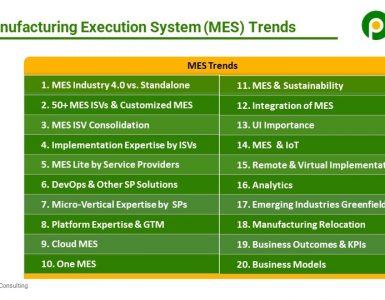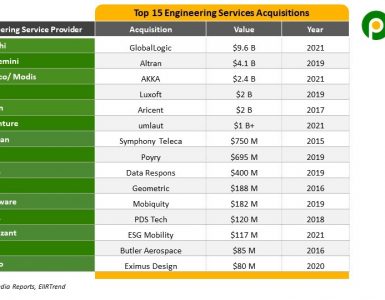Over the past few years, software engineering service providers have experienced industry-leading growth and received impressive valuations. However, with growth rates tapering off recently, there's a renewed sense of optimism. The emerging trend of Generative AI, often abbreviated as GenAI, might be the catalyst for the next surge in the growth of software engineering services.
Engineering GenAI Use Cases vs. GenAI Engineering
Let's distinguish between "Engineering GenAI" and "Gen AI Engineering." GenAI will influence the engineering services market in two distinct manners:
- The first “Engineering GenAI” pertains to the application of GenAI in various engineering functions such as product design, product engineering, manufacturing, and operations. This has its unique path of development and growth.
- The second, "GenAI Engineering," concerns the facilitation of GenAI across various industries and services. This area holds a broader scope and is particularly significant for digital engineering service providers. In this blog, our focus will be on "GenAI Engineering."
Major IT Waves and Evolution of Software Engineering Services
The progression of software engineering services closely mirrors the development of enterprise IT. Significant changes in software engineering align with major shifts in IT trends. As each new IT wave emerges, software engineering expands its offerings and reaches a broader user base. With the recent surge in AI, we anticipate that software engineering will continue to evolve, catering to an even wider range of customer requirements.

Wave 1: Custom Applications.
The first wave of enterprise IT revolved around creating custom software applications for a variety of platforms, ranging from mainframes to micro and minicomputers, each with its own operating system and programming language.
It was during this wave that the foundations of software engineering were laid. Enterprises and service providers began to discern the distinctions and parallels between developing software products and custom applications.
Wave 2: Enterprise Applications & Software Product Engineering.
The second wave of enterprise IT shifted from custom applications to standardized enterprise applications provided by Independent Software Vendors (ISVs). These applications catered to both specific industry verticals and general business functions, encompassing areas like ERP, HCM, CRM, and SCM. Consequently, IT service providers transitioned from Application Development and Maintenance (ADM) to a focus on Enterprise Application Integration or System Integration.
As these ISVs grew in prominence, they required external assistance in areas like product development, testing, maintenance, and support. This gave rise to the concept of Outsourced Product Development (OPD), which emerged as a specialized service offering.
Several OPD-centric service providers, such as EPAM, Globant, Luxoft (now under DXC), GlobalLogic (now a part of Hitachi), Thoughtworks, Persistent, Ness, Symphony Teleca (now a part of Harman), and others, began gaining market traction. A few big service providers, like HCL, also ventured into the OPD realm. However, the OPD sector largely remained niche, often overlooked by many big IT service providers. Larger IT service providers tended to approach this market with an opportunistic mindset rather than a strategic focus.
Wave 3: Digital & Digital Engineering
Digital transformation presented a significant opportunity for IT service providers. Initially labeled as SMAC (Social, Mobility, Analytics, Cloud), it soon became universally recognized as "digital," emphasizing the integration of advanced technologies. This shift was a boon for IT service providers as businesses sought to modernize their technological stack and explore new avenues.
For those in the Outsourced Product Development (OPD) or software product engineering space, digital presented an even more significant opportunity. As enterprises began developing their own digital platforms, there was an urgent need to modernize and move to the cloud. Central to this digital transformation was digital engineering, encompassing specialties like platform engineering and cloud engineering.
Having emerged prominently in the prior wave of enterprise applications, OPD and software product engineering providers had honed their product development skills. Their extensive experience in product creation positioned them persuasively as experts in platform and cloud engineering.
Recognizing the potential, larger IT service providers also pivoted toward digital engineering. They discerned its vital role in enterprise digital transformation. Essentially, digital engineering formed the crux of software platform development and the underlying digital framework. In response, nearly all major IT service providers began offering digital engineering services, either through in-house developments or acquisitions.
The pandemic further propelled the demand for digital engineering. Many digital engineering firms witnessed remarkable growth and impressive valuations. For instance, GlobalLogic, boasting near billion-dollar revenues, was acquired by Hitachi for $9.6 billion. Similarly, Thoughtworks, with comparable revenues, launched an IPO with a similar market capitalization. Other digital engineering providers also demonstrated impressive trajectories.
However, as the macroeconomic conditions shift and the surge in digital demand from the pandemic begins to plateau, growth rates are trending downwards, and the industry is looking for the next growth driver.
Wave 4: AI & AI Engineering
Now, the next wave in IT, Generative AI (GenAI), is emerging. Enterprises are discussing the potential applications of GenAI, and service providers are making significant investments in this domain.
Much like during the digital wave, engineering will be a critical component in the GenAI wave. Enterprises will have to identify, gather, clean, and format their data to make it compatible with GenAI. This process falls under the domain of data engineering. The introduction of multiple Large Language Models (LLMs), combined with security issues and challenges related to data availability, will complicate the integration of GenAI into both on-premise and cloud software solutions.
This scenario presents a golden opportunity for engineering service providers. They can enhance their Data Engineering and AI engineering services to accommodate LLMs, assisting enterprises in their transition to and implementation of GenAI.
Bottomline: The growing interest and investment in GenAI are reminiscent of a gold rush. During such rushes, it's often the companies that provide the necessary tools, like shovels, emerge as major winners. In the context of GenAI, the direct counterparts of these shovel companies are hardware and chip manufacturers, such as Nvidia. However, there are less obvious players in this analogy, like AI and data engineering service providers. These entities will assist businesses in integrating GenAI. While there are ample opportunities in this sector, the competition is expected to be fierce. Unlike previous IT waves, engineering service providers won't have a head start this time around and will face competition from various stakeholders in the ecosystem. The success of these engineering service providers will hinge on how well their strategy, execution, and investments align with market growth. Nonetheless, this surge in GenAI interest is a promising sign for the engineering services industry.






 Pareekh Jain
Founder of Pareekh Consulting & EIIRTrends
Pareekh Jain
Founder of Pareekh Consulting & EIIRTrends
Add comment